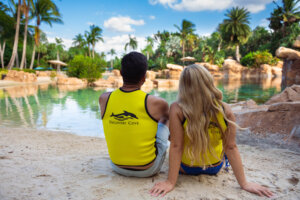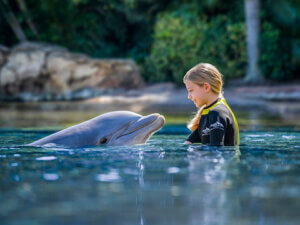On Friday 30 October, whale watching boats spotted a humpback whale in distress near Balboa Pier in Newport Beach, California.
Rescuers from the National Marine Fisheries Service (NMFS) and other local agencies responded and were able to cut about 100 feet of the line away before attaching a poly ball. This enables rescuers to keep track of the whale and also gives them something to attach a knife or hook to when it comes time to cut more line.
NMFS notified SeaWorld that the whale was heading south. SeaWorld then prepared gear, two rescue boats and assembled a team, led by Keith Yip, who is SeaWorld’s curator of mammals and is in charge of the park’s stranded animal programme.
At 9:30 a.m. on Saturday 30 October, Yip and the SeaWorld Rescue Team were notified by San Diego Lifeguards that the whale was spotted off La Jolla Cove (15 miles north of San Diego). The team headed that way in two boats and quickly spotted the poly ball and the whale. The whale was an adult humpback, estimated to be between 40 and 50 feet long.
There were two lines trailing from the mouth of the whale down the length of its body that joined into snarl. The “snarl” (about eight inches in diameter) trailed about six feet behind the whale and then there was an additional 230-plus feet of line
After assessing situation, the team decided the first goal was to get the snarl of lines off of the whale, which they were successful at doing by using a flying knife. They shut the engine off, attached to the poly ball line, and then pulled themselves hand over hand letting the whale drag the boat, this is called a ‘sleigh ride’, until they were able to cut the snarl off.
Next goal was to cut the second line of rope. The team regrouped, got within 50 feet of the whale and attached a grapple. The whale stopped and they were able to pull themselves closer and reach down and cut the line with a folding knife. The whale swam free from the Rescue Boats. The team was engaged in the rescue process for three hours and travelled about five miles with the whale.
It is important to note that while it is hoped that the whale will be able to survive, the team is realistic with regards to the ultimate outcome for this animal. A significant amount of line was removed from the whale yesterday and today, however, there is still line in its mouth. Thus, this is considered a partial disentanglement by the National Marine Fisheries Service with a reasonable concern for its future. While the removal of a significant amount of fishing gear will greatly increase the animal's chances of survival, it is hoped that the remaining gear, which was cut short and now only involves a single pass through the mouth, will be dislodged over time.



